Buying timed tickets to visit museums seems to be the necessity these days… which works okay, if you are travelling just for leisure, I guess and you don’t mind planning out your every single day of what you are doing on your vacation. But when travelling for work, and finding you might have a few hours to squeeze in something cultural – having to have pre-purchased tickets weeks in advanced leaves you at the mercy of some pretty mercenary resellers, mostly found on Trip Advisor links.
We did manage to get tickets for the morning we suddenly had available, but they were general entry and untimed, so that puts you in a different queue to get into the building, and that can mean ages waiting in lines. Thankfully at 0900 on a Saturday morning, the queues weren’t too intolerable and we were able to visit the Musée D’Orsay somewhat spontaneously after all.



Van Gogh self portrait.. another one. Oil on canvas.


Bedroom At Arles.
Vincent Van Gogh, 1888, oil on canvas… this is my favourite Van Gogh painting. I just can’t get over the texture he created which you an only see in person. This painting utterly fails to translate in reproductions.


The Church in Auvers-sur-Oise, View of the Chevet.
Vincent Van Gogh, 1890, oil on Canvas.
Mr K’s favourite. Something to do with a Dr Who episode? Huh?
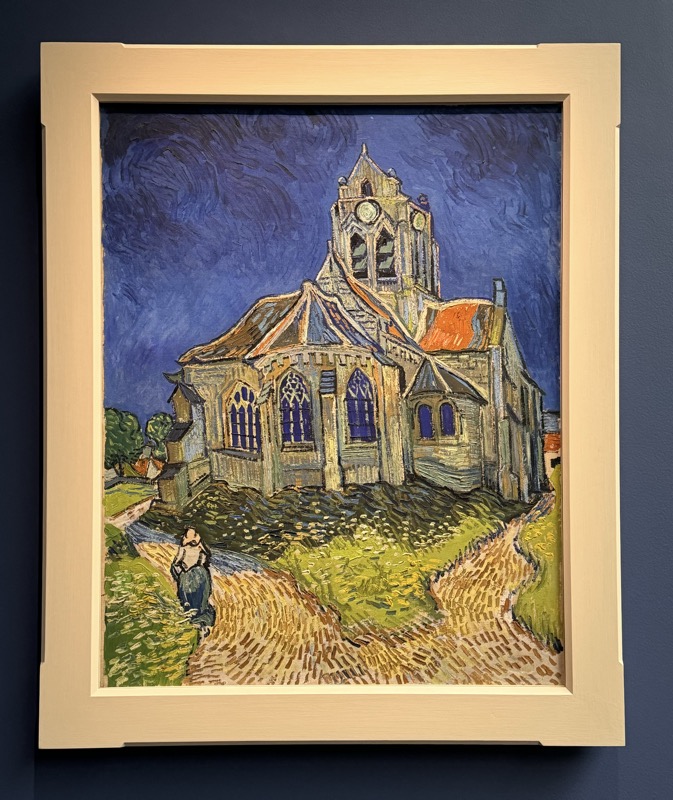

Chrysanthemums.
Claude Monet, 1878, oil on canvas. Part of the Doctor Gachet collection, I quite liked this painting even though it isn’t typical of Money and has an odd perspective.


The Starry Night.”
Vincent Van Gogh, 1888, oil on canvas.



La Guinguette a Montmartre; Le Billard en bois, La Bonnie franquette.
Vincent Van Gogh, 1886, oil on canvas.

Fritillaires couronne impériale dans un vase de cuivre.
Vincent Van Gogh, 1887, oil on canvas.

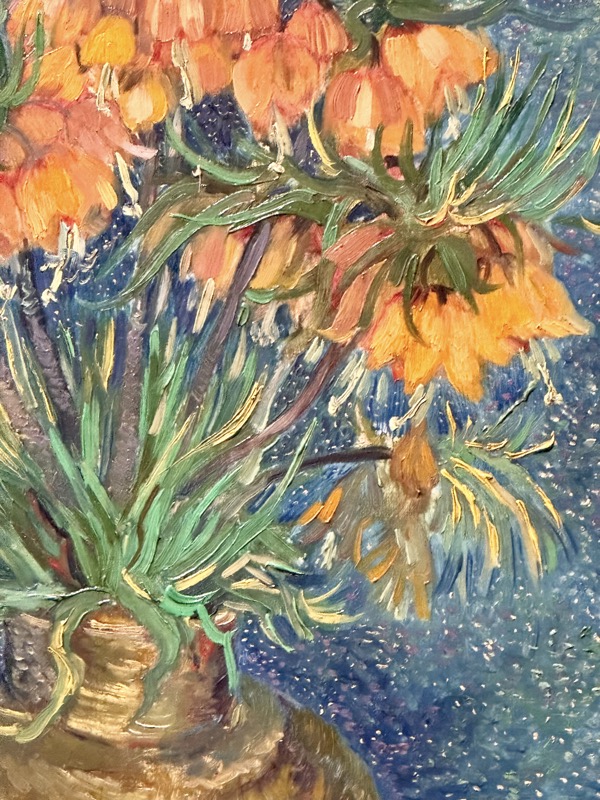


Blue Water Lilies.
Claude Monet, 1916-1919, oil on canvas.
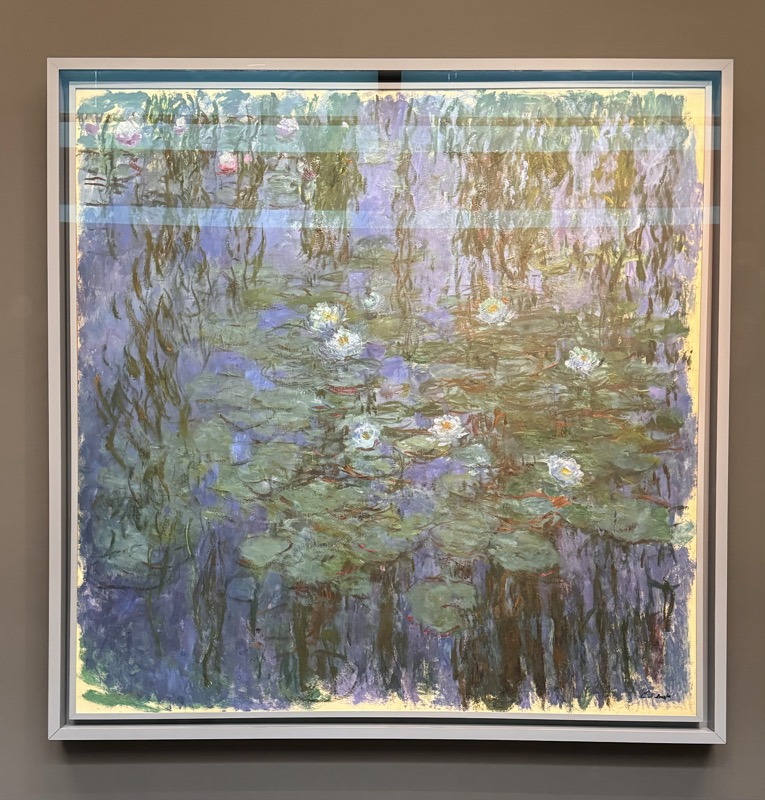
En norvégienne, also called, La barque à Giverny.
Claude Monet, 1887, oil on canvas.

Femme au fichu vert.
Camille Pissarro, 1893, oil on canvas.

Foyer de la Danse.
Edgar Degas, 1872, oil on canvas.
Not sure what to make of Degas, I’ve always admired the work and the spaces he depicted of the opera world and the ballet school always lent themselves to beautiful compositions – very elegant and feminine. As I get older though, I wonder whether he was a sneezy presence (like Trump at a beauty pageant) walking in like he owned the place and ogling half-naked, very young women… many of whom were expected to be congenial to patrons of the arts. :/


Blue Dancers.
Edgar Degas, 1893, oil on canvas.

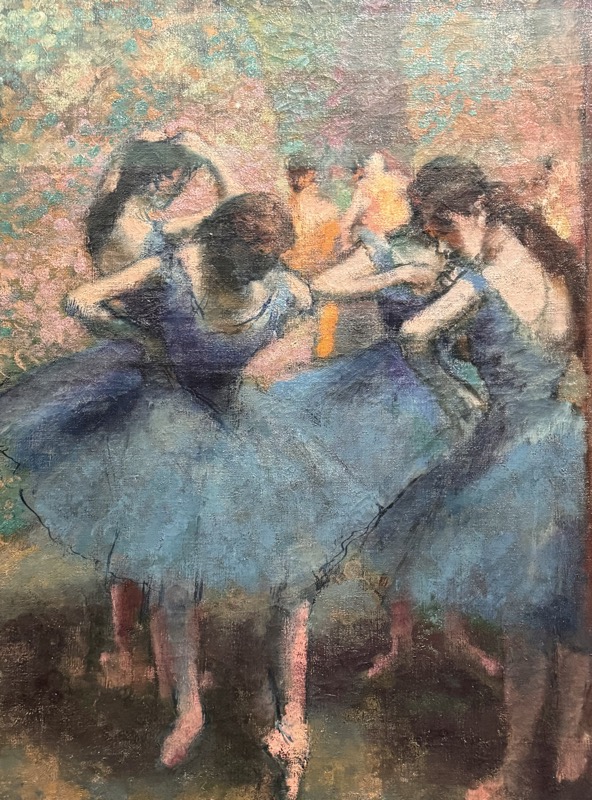
The Ballet Class
Degas, 1874, oil on canvas.
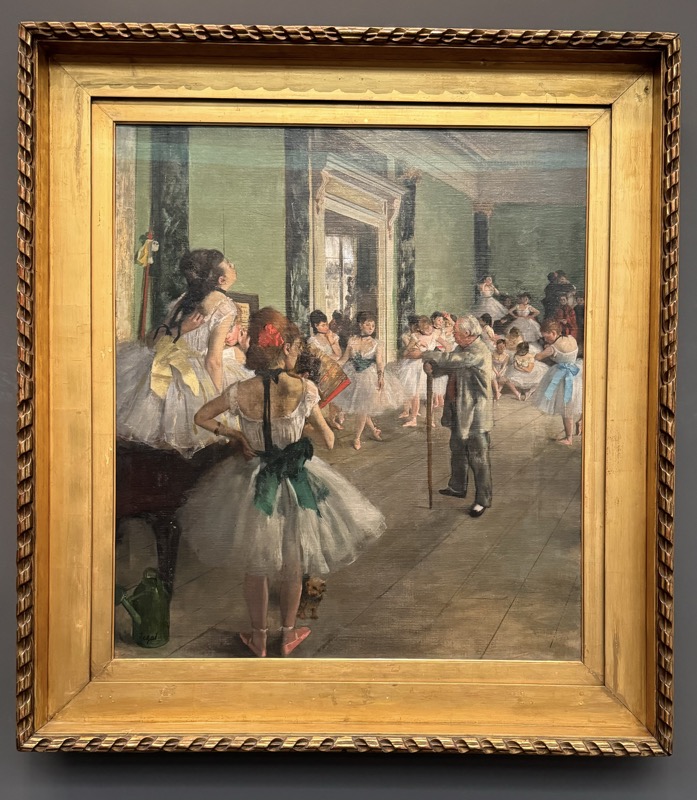
La Place Valhubert.
Armand Guillaumin, 1875, oil on canvas.

La Dame aux éventails.
Édouart Manet, 1873, oil on canvas. The model is Nina de Callias, she was a musician and artiest herself.

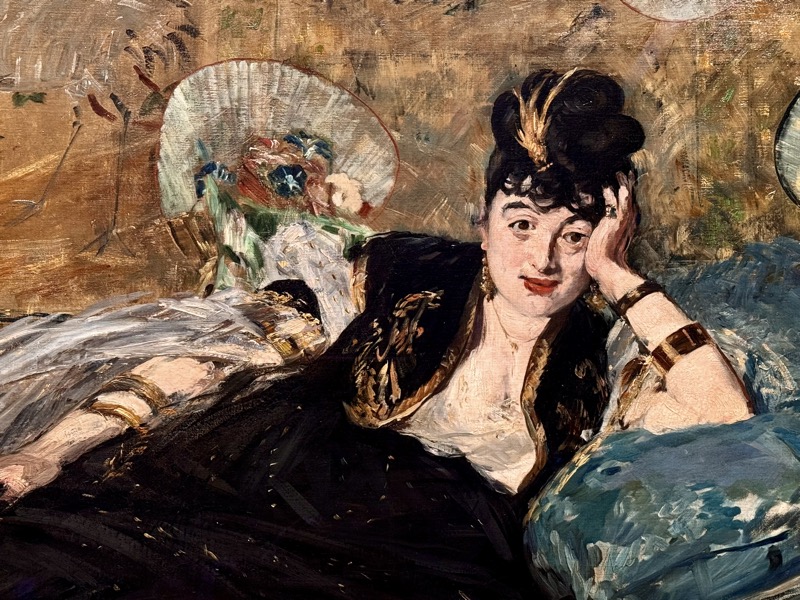
City Dance and Country Dance.
Pierre-Augusta Renoir, 1883, oil on canvas.

Le Cathédrale de Rouen. Also called, Harmonie Bleue et Or.
Claude Monet, 1894, oil on canvas.

Woman with a Parasol Facing Right, and Woman with a parasol Facing Left.
Claude Monet, 1885, oil on canvas. The mondella was named Suzanne Hoschedé who was the daughter the impressionist collector Ernest Hochedé, but these were not meant as portraits. His outdoor figures were attempting to capture the landscape as the subject.

Henri-Edmond Cross.
Maximilien Luce, 1898, oil on canvas… I quite like this one, it’s amazing how much detail is conveyed with such frugal brush strokes and no blending to speak of. Beautiful.


Le Quai Saint-Michel et Notre-Dame.
Maximilien Luce, 1901, oil on canvas.


Georges Seurat’s Palette from 1891… what a cool object to have here – obviously it’s oil paint on timber.

The museum has imagery all around the place of the ‘Sunday Afternoon on the Island of La Grande Jatte’, which is one of those annoying things museums seem to do these day to create interest – but of course it isn’t here, it’s at the Art Institute of Chicago. They do have some very small studies that were done for the painting though. These are barely A4 in size, the full painting is 2m high and 3m wide.


Circus.
Georges Surat, 1890-1891, oil on canvas. This work is considered incomplete as Surat died prematurely while working on it. I’ve often wondered about the curatorial choices that go into displaying some of these well known or important works – but apparently Surat chose this blue frame himself.



Couple dans la rue.
Charles Angrand, 1887, oil on canvas.


La Seine à Herblay.
Maximilien Luce, 1890, oil on canvas.


Entrée du port de la Rochelle.
Paul Signac, 1921, oil on canvas… this one was an unexpected little gem that I just loved. The colours are so vibrant and beautiful, and again, such beautiful texture created by the brushwork.



Jardins publics: L’interrogatoire.
Édouard Vuillard, 1894-1936, oil on canvases.


Et l’or de leur corps.
Paul Gauguin, 1901, oil on canvas. I have little affection for Gauguin – partly because I don’t really enjoy his style, but also because I think he just spent years in Tahiti shafting native women. :/

Jane Avril Dancing.
Henri de Toulousse-Lautrec, 1892, thinned oil paint on poster board.

The Robe.
c.1982, distemper on flannel (?)


The restaurant was closed but looked very funky… love the colourful chairs.

Logement prolétaire (Proletärkarsern).
Eugène Jansson, Stockholm, 1898, oil on canvas.

La pointe d’Andey, Vallée de L’Avre.
Ferdinand Hodler, 1909, oil on canvas.

Portrait de l’artist au fond rose.
Paul Cézanne, c. 1875, oil on canvas.


Hercules Kills the Birds of Lake Stymphalia.
Antoine Bourdelle, 1880-1910, bronze.

Le Belier Retif, also called, Belier African.
Antoine Bourdelle, 1909, bronze.

Monument à Jean-Jacque Rousseau…
La Philsophie (centre), with La Verite et la Nature.
La Gloire et La Musique (sides).
Albert Bartholomé, 1910, sculpture en platre

Jeunesse.
Aristide Maillol, 1910, marble.
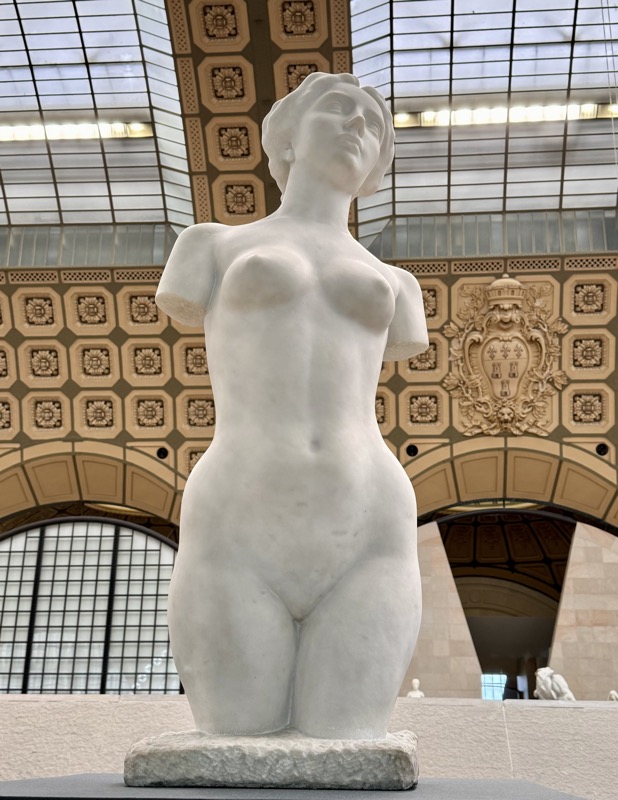
Judgement de Paris.
Pierre-Auguste Renoir, 1914, Platre (signed and dated Renoir).


Les Nubiens, also called, Les Chasseurs d’Alligators.
Ernst Barrias, 1894, platre.
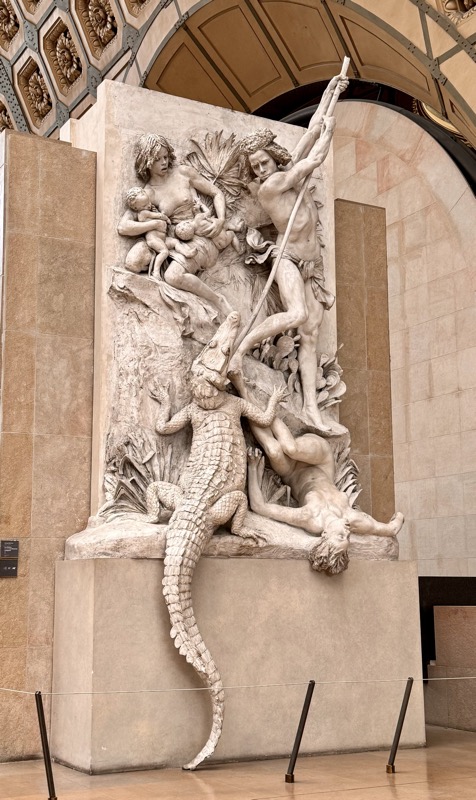

La Roue de la Fortune (Wheel of Fortune).
Edward Burne-Jones, c1875-1883, oil on canvas.


Mercure inventant le caducée.
Jean Antoine Idrac, 1878, marble.

I didn’t get the description for this one… I liked her, even though the poor dear looks like she’s lost her portable! Selfie Queen.

Polar Bear.
Francois Pompon, c.1923-1933, stone.
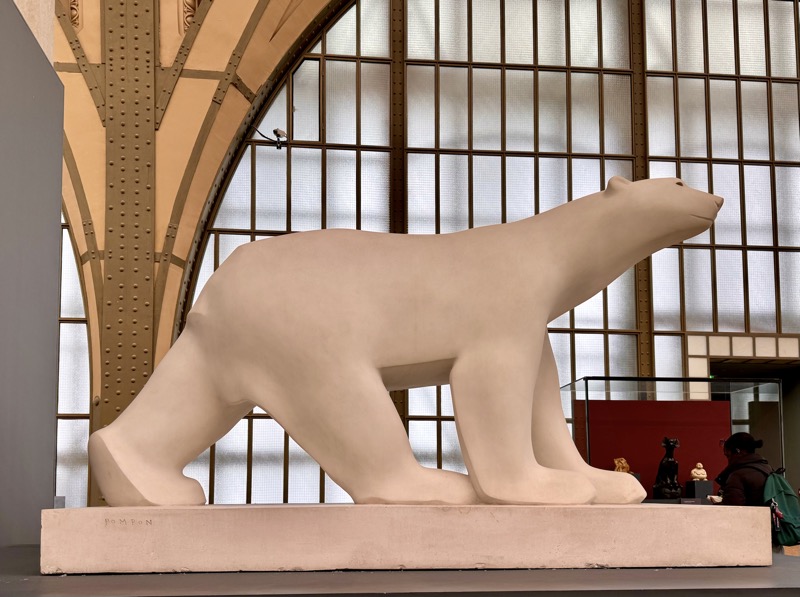
Pompon famously worked with Rodin, but chose animals as his focus. This bear was one he watched pace in a cage at the zoo in the Jardins des Plantes, and was carved from a 3 tonne stone… every bit of it that wasn’t polar bear was removed and he is remarkably sleek and modern looking, even today.

We had to bail on the Musée D’Orsay, as we had skipped breakfast and were getting seriously hungry. Went for a bit of a wander to find lunch… on the way, the famous: Sorbonne University.

Lunch Bistro, chosen by Mr K;

Very nice choice. Many bistros will have a daily menu that gives you choices of two or three course meals at very reasonable prices – this is how Parisians often order their lunches, rather than a la carte. So we took that option. Jambon et fromage crépes, steak au poivre for Mr K, boeuf bourguignon for me, crème caramel for Mr K, and I spoiled myself with a crème brulee. Delicious and now we’ll be skipping dinner too!
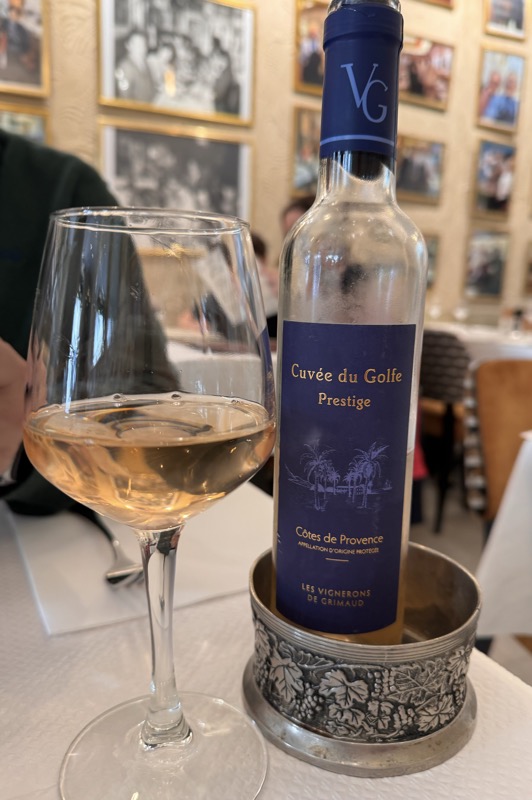

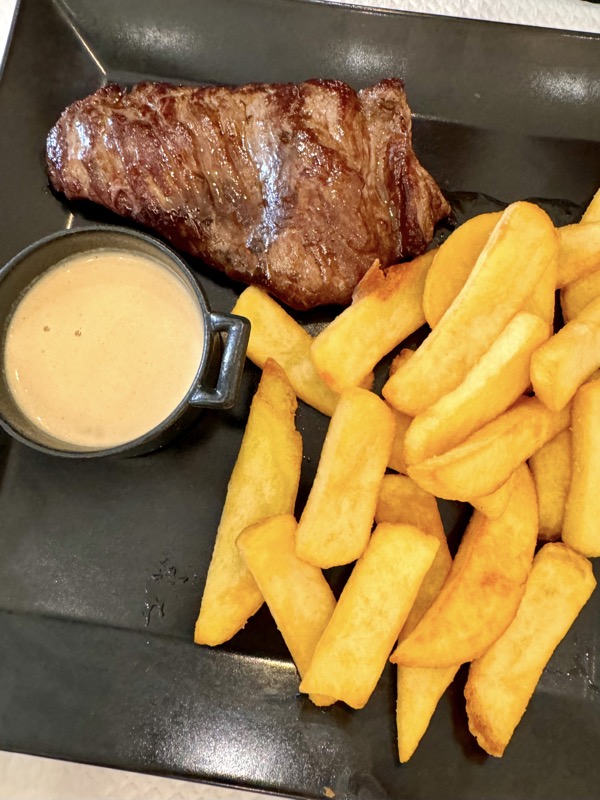









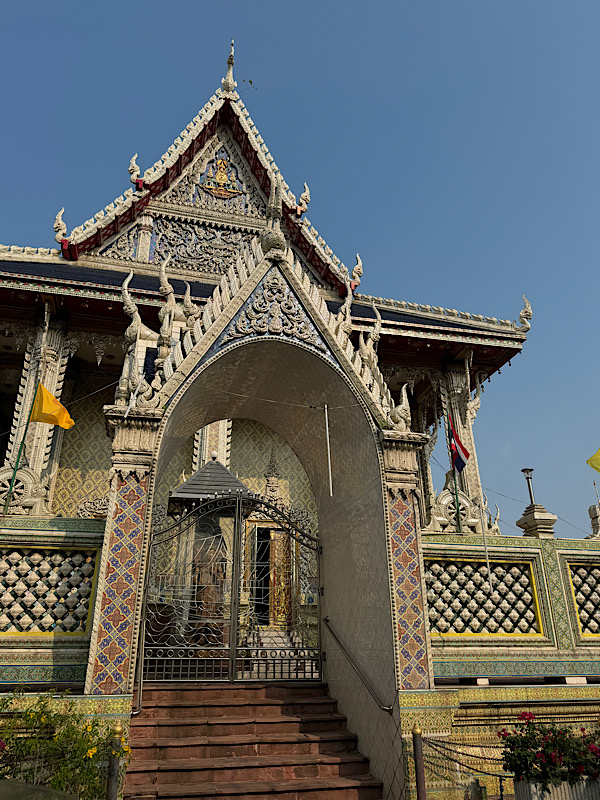








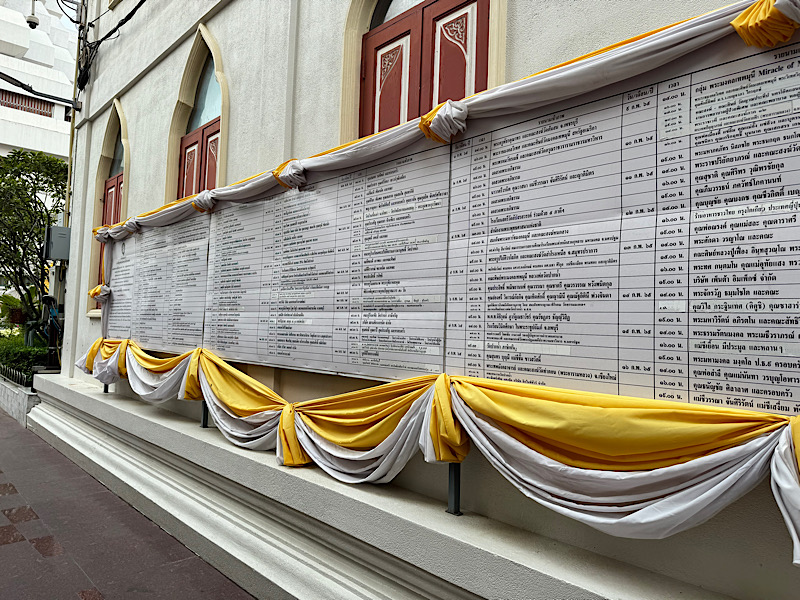

















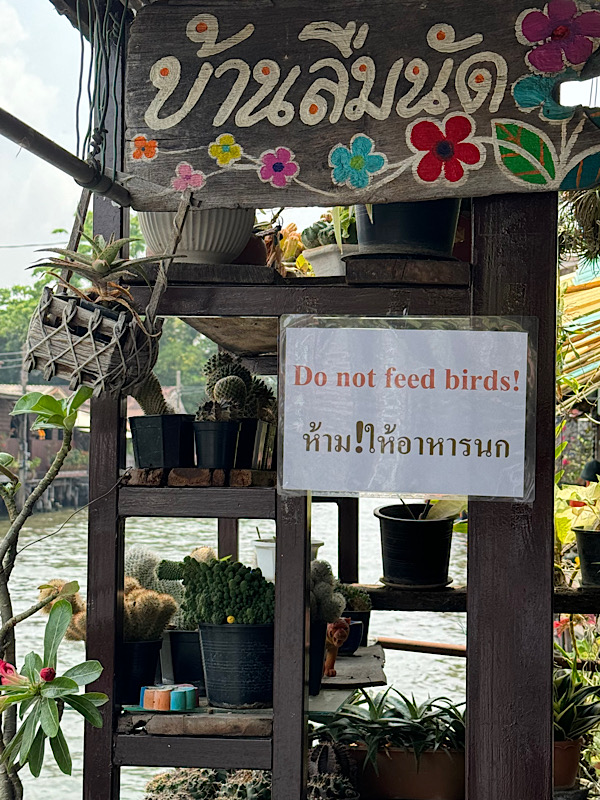







 Now, everyone, knows transit days suck balls… big hairy sweaty ones on occasion, and this is why the No 1 Golden Rule of Travel is: Never plan to go sightseeing on transit days! So what did these very well travelled individuals plan for today? Well, we broke the stupid rule and planned to disembark the ship in Yokohama, take a train to Kyoto, put our luggage in storage, and go to the famous Minamiza Theatre in Gion to see the Mikayo Odori Spring Dances. It’s barely a 20 minute trip on the Shinkansen from Osaka to Kyoto, and ideally, we would have come back at some point over the next week to see this uniquely Japanese cultural experience – but the season quite literally ends today, and we were able to buy tickets for the second last performance for 2019. So here we were, breaking the Travel Rules.
Now, everyone, knows transit days suck balls… big hairy sweaty ones on occasion, and this is why the No 1 Golden Rule of Travel is: Never plan to go sightseeing on transit days! So what did these very well travelled individuals plan for today? Well, we broke the stupid rule and planned to disembark the ship in Yokohama, take a train to Kyoto, put our luggage in storage, and go to the famous Minamiza Theatre in Gion to see the Mikayo Odori Spring Dances. It’s barely a 20 minute trip on the Shinkansen from Osaka to Kyoto, and ideally, we would have come back at some point over the next week to see this uniquely Japanese cultural experience – but the season quite literally ends today, and we were able to buy tickets for the second last performance for 2019. So here we were, breaking the Travel Rules.
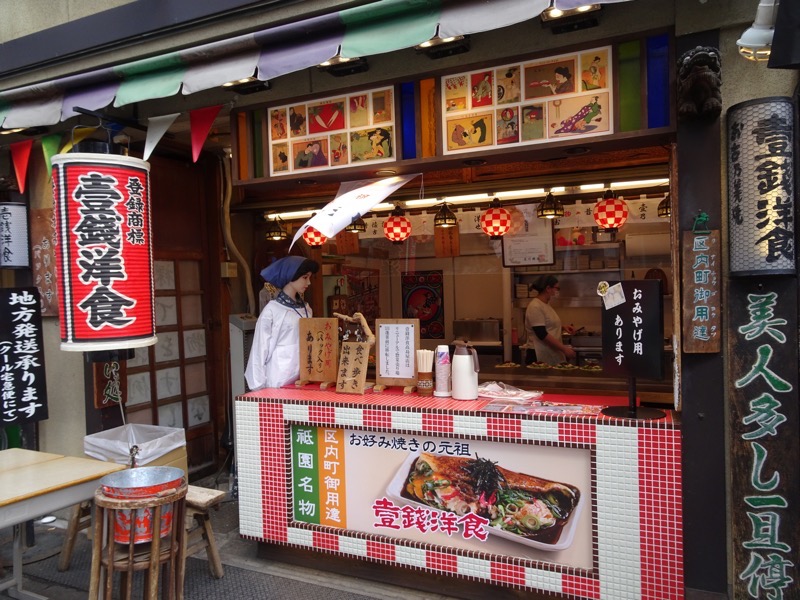

 The Miyako Odori spring dances have been held at the Minimaza theatre (which was built in the 1600s) since the late 1800s. The place has quite a history and each year the dances are designed to celebrate the spring/cherry blossom season and to show off the talent of the maiko – the apprentice geisha who grace the Hanamachi, (the ‘Flower Town’ pleasure district) of Gion that is full of historic ochaya (teahouses) and okiya (geisha houses).
The Miyako Odori spring dances have been held at the Minimaza theatre (which was built in the 1600s) since the late 1800s. The place has quite a history and each year the dances are designed to celebrate the spring/cherry blossom season and to show off the talent of the maiko – the apprentice geisha who grace the Hanamachi, (the ‘Flower Town’ pleasure district) of Gion that is full of historic ochaya (teahouses) and okiya (geisha houses).

 I remember these kimono from when we were last in Kyoto in 2015 – we visited an exhibition called ‘The Maiko Story’ that highlighted the history and traditions of the lives of the maiko and geiko that grace Gion. Today we would get to see the maiko dancing in them.
I remember these kimono from when we were last in Kyoto in 2015 – we visited an exhibition called ‘The Maiko Story’ that highlighted the history and traditions of the lives of the maiko and geiko that grace Gion. Today we would get to see the maiko dancing in them. 
 There is no photography allowed in the theatre during performances, so I have ‘borrowed’ some images from official promotional material and ever helpful Wikipedia. The costumes were lovely, the dancing was precise, graceful and exactly what I expected to see from these highly trained artisans. The music, however, was at various points during the performance ear piercingly painful! The flutes, they’re so high! Ouch. The singing too, while not as bad as the caterwauling we experienced at various cultural performances in China, was likewise not always ‘pleasant’. Still, it was quite the visual spectacle and it was wonderful to add this quintessentially Japanese experience to our ‘When in Rome’ List.
There is no photography allowed in the theatre during performances, so I have ‘borrowed’ some images from official promotional material and ever helpful Wikipedia. The costumes were lovely, the dancing was precise, graceful and exactly what I expected to see from these highly trained artisans. The music, however, was at various points during the performance ear piercingly painful! The flutes, they’re so high! Ouch. The singing too, while not as bad as the caterwauling we experienced at various cultural performances in China, was likewise not always ‘pleasant’. Still, it was quite the visual spectacle and it was wonderful to add this quintessentially Japanese experience to our ‘When in Rome’ List.
 The final scene was quite the spectacle with all the performers returning to the stage and dancing in unison – except for two obviously very senior geiko who seemed to be marching to their own tune.
The final scene was quite the spectacle with all the performers returning to the stage and dancing in unison – except for two obviously very senior geiko who seemed to be marching to their own tune.
1_fvde-2f.jpg) After the performance was over we hopped another cab back to the Post Office to collect the luggage and made our way back to the Shinkansen to catch a train to Osaka. Thankfully, we didn’t have much trouble finding seats – it is the Tokyo to Kyoto segment that seems to be super popular at the moment and we were not surprised given it is Golden Week.
After the performance was over we hopped another cab back to the Post Office to collect the luggage and made our way back to the Shinkansen to catch a train to Osaka. Thankfully, we didn’t have much trouble finding seats – it is the Tokyo to Kyoto segment that seems to be super popular at the moment and we were not surprised given it is Golden Week. After we got settled, we were a bit shattered to be honest (that is what you get for breaking the Travel Rules), so Keith popped out for some milk to make tea and some sake for well,…for obvious reasons really! Eventually, we opted to go out for a late dinner and we ended up at a restaurant called
After we got settled, we were a bit shattered to be honest (that is what you get for breaking the Travel Rules), so Keith popped out for some milk to make tea and some sake for well,…for obvious reasons really! Eventually, we opted to go out for a late dinner and we ended up at a restaurant called  Dinner was a delicious boat of fresh sashimi, some takoyaki and yakitori and of course sake! (If it looks like I am using alcohol to help me sleep in the absence of some of my medications and my own bed – that is probably because I am!)
Dinner was a delicious boat of fresh sashimi, some takoyaki and yakitori and of course sake! (If it looks like I am using alcohol to help me sleep in the absence of some of my medications and my own bed – that is probably because I am!) The place has a lively atmosphere, a lot of laughter from the rabbit warren of individual little dining rooms, and the free-flowing liquor. If it weren’t for the Japanese propensity to let people still smoke cigarettes in these types of restaurants, I’d say it was a perfect fun spot with great food and we’ll be back – but, there are too many other places to try and if we can find great food sans smoking, we’d much prefer it.
The place has a lively atmosphere, a lot of laughter from the rabbit warren of individual little dining rooms, and the free-flowing liquor. If it weren’t for the Japanese propensity to let people still smoke cigarettes in these types of restaurants, I’d say it was a perfect fun spot with great food and we’ll be back – but, there are too many other places to try and if we can find great food sans smoking, we’d much prefer it. 
 Then, it was time to head back to the hotel, write all this guff up before we have new adventures tomorrow and I forget all about the details of today.
Then, it was time to head back to the hotel, write all this guff up before we have new adventures tomorrow and I forget all about the details of today. Ikebukuro Main Street.
Ikebukuro Main Street.


 And then we found the place – basically a Disney Store but for Pokémon, and at this time of year – packed to the gills with people, lots of loud annoying music, kids running amok and more plush toys than you can poke a stick at.
And then we found the place – basically a Disney Store but for Pokémon, and at this time of year – packed to the gills with people, lots of loud annoying music, kids running amok and more plush toys than you can poke a stick at.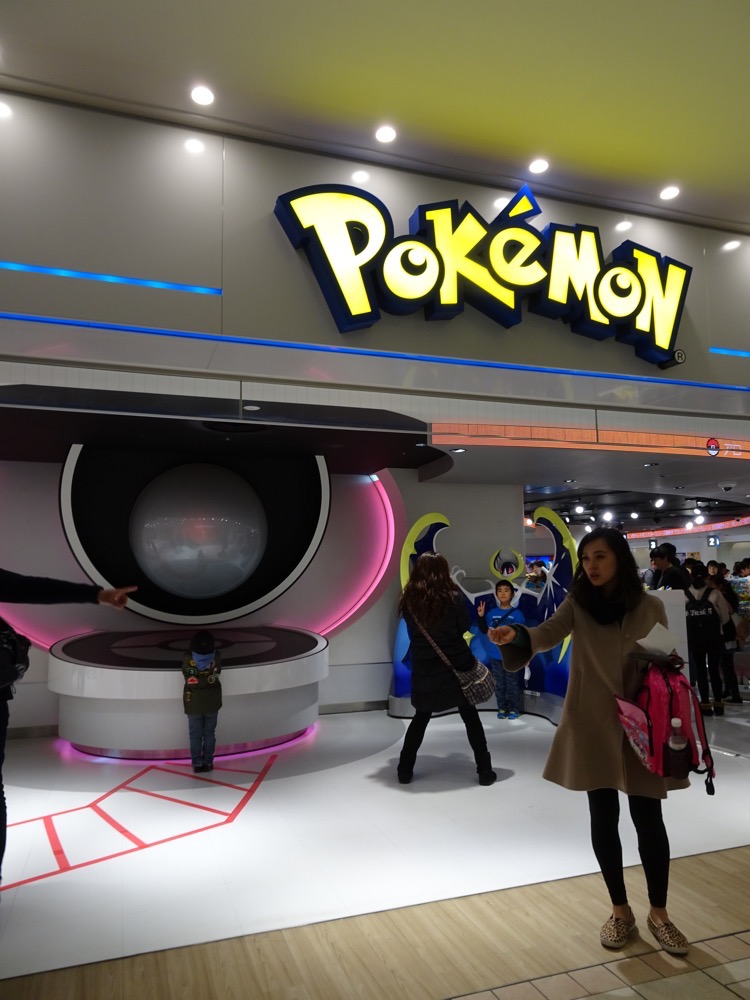


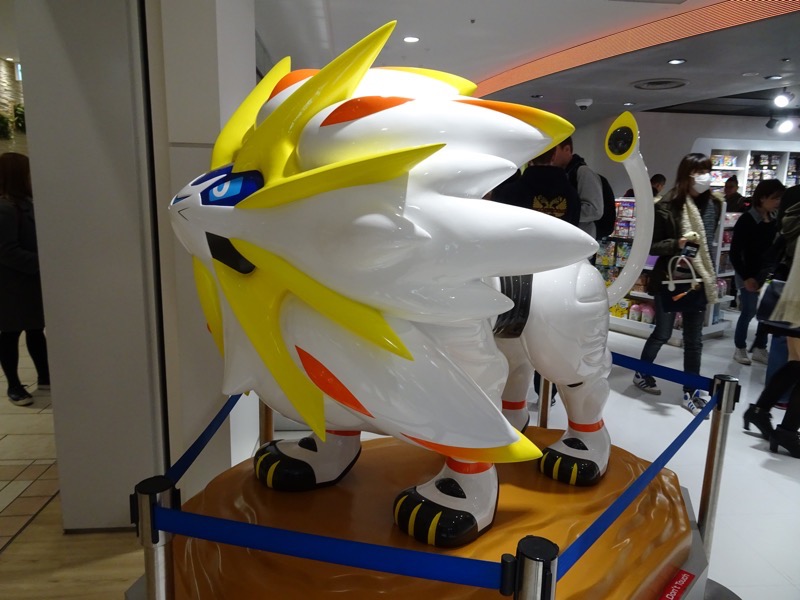


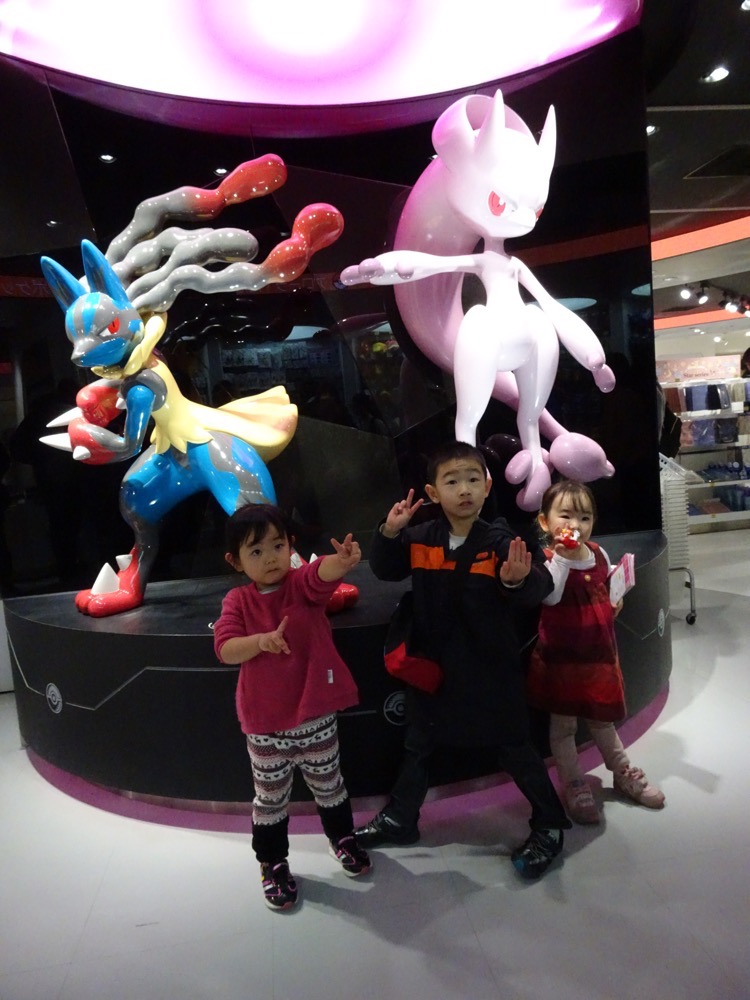 Unfotunately not a lot of merchandise that was designed for adults… I was hoping to find something I could buy in bulk to take home for our local raid teams, but seriously? Golf balls, stationery or phone cases was about the extent of useful stuff that adults might like. I don’t think they are catering for their PGO market here – which from what I have seen is largely being played by 25-45 year olds. Oh well. Marketing opportunity missed there, Nintendo.
Unfotunately not a lot of merchandise that was designed for adults… I was hoping to find something I could buy in bulk to take home for our local raid teams, but seriously? Golf balls, stationery or phone cases was about the extent of useful stuff that adults might like. I don’t think they are catering for their PGO market here – which from what I have seen is largely being played by 25-45 year olds. Oh well. Marketing opportunity missed there, Nintendo.



 While we were there a legendary raid popped on the Pokemon Mega Centre gym, so of course we had to raid the Groudon. I managed to catch it, but Mr K had to try again on the other Pikachu gym right beside it.
While we were there a legendary raid popped on the Pokemon Mega Centre gym, so of course we had to raid the Groudon. I managed to catch it, but Mr K had to try again on the other Pikachu gym right beside it.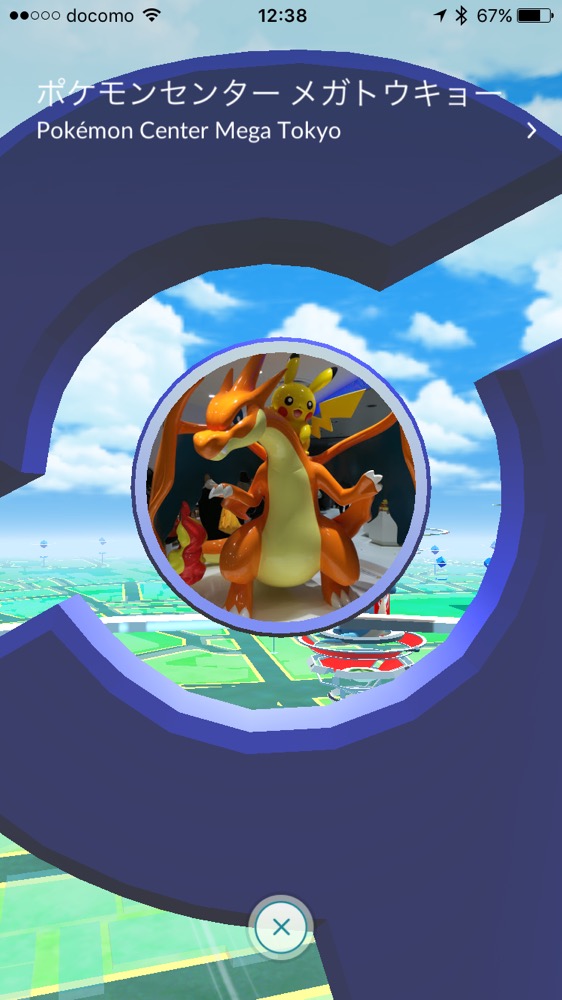
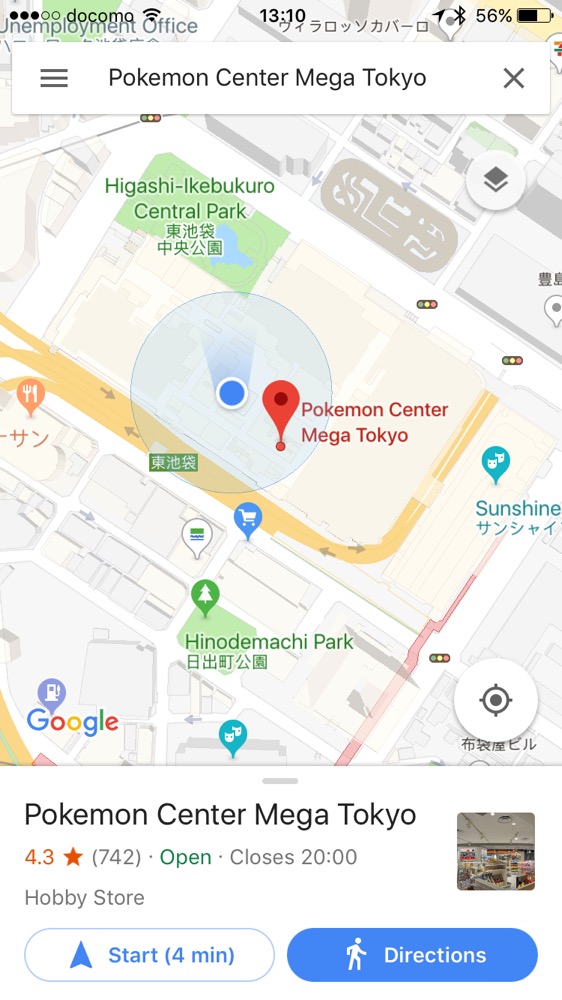



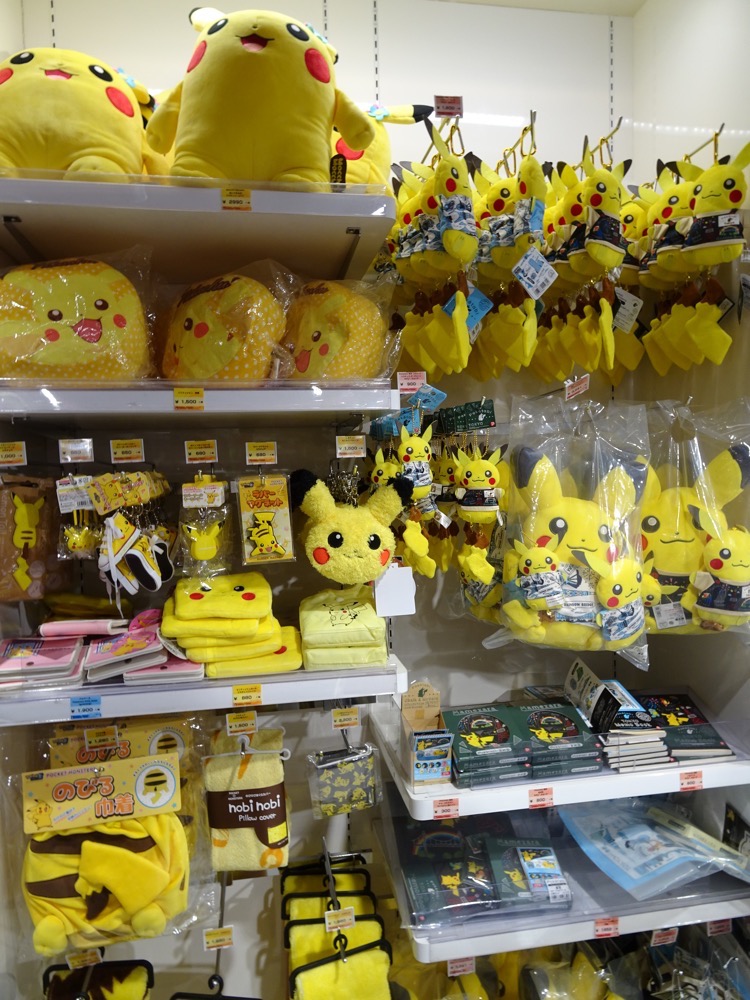 Just as we were leaving, things got really out of control – a Santa Pikachu turned up with the staff and the kids went crazy! So much noise and excitement and absolutely none of it decipherable by non-Japanese speaking tourists like us.
Just as we were leaving, things got really out of control – a Santa Pikachu turned up with the staff and the kids went crazy! So much noise and excitement and absolutely none of it decipherable by non-Japanese speaking tourists like us. And of course the ubiquitous vending machines full of Pokemon crap. Mostly Ditto for some reason…
And of course the ubiquitous vending machines full of Pokemon crap. Mostly Ditto for some reason…
 For lunch, we found this restaurant which had some amazing looking okonomyaki in the display window… well, amazing for over glossy plastic representations of food, but we thought it looked like a potentially delicious cabbagey omelette spot for lunch.
For lunch, we found this restaurant which had some amazing looking okonomyaki in the display window… well, amazing for over glossy plastic representations of food, but we thought it looked like a potentially delicious cabbagey omelette spot for lunch.

 However, we got inside and rapidly discovered that it was teppanyaki okonomiyaki? Cook your own damn cabbagey omelette restaurant? The Teenager looked somewhat unimpressed at having to cook his own lunch, but when in Rome, right?
However, we got inside and rapidly discovered that it was teppanyaki okonomiyaki? Cook your own damn cabbagey omelette restaurant? The Teenager looked somewhat unimpressed at having to cook his own lunch, but when in Rome, right?  There was a pile of useful instructions, not in English of course, but it gave comfort knowing that locals don’t necessarily know how to cook their own okonomyaki either. 😉
There was a pile of useful instructions, not in English of course, but it gave comfort knowing that locals don’t necessarily know how to cook their own okonomyaki either. 😉  Our lunches arrived – raw. And looked full of possible deliciousness… so long as I didn’t fuck up the cooking bit. 😀
Our lunches arrived – raw. And looked full of possible deliciousness… so long as I didn’t fuck up the cooking bit. 😀  Thankfully, our server was kind enough to show us how it’s done – for the first one. Preparing the plate, cooking the meat/seafood, mixing the cabbagey mixture and then forming it into a 14cm pancake. Cook covered on one side for 4 mins on a lowish temperature, then use the spatulas to flip it over and cook for another 4 mins on the other side. Handy hourglass timers were provided to make sure your okonomyaki was cooked through.
Thankfully, our server was kind enough to show us how it’s done – for the first one. Preparing the plate, cooking the meat/seafood, mixing the cabbagey mixture and then forming it into a 14cm pancake. Cook covered on one side for 4 mins on a lowish temperature, then use the spatulas to flip it over and cook for another 4 mins on the other side. Handy hourglass timers were provided to make sure your okonomyaki was cooked through. 
 Et voila! Tasty tasty okonomyaki lunch!
Et voila! Tasty tasty okonomyaki lunch!

 Lunch was delicious and went down lovely with a cold glass of umeshu and biru.
Lunch was delicious and went down lovely with a cold glass of umeshu and biru.
 He was pretty excited to be there… but only pulled this face for me after I prompted him to not look so blasé.
He was pretty excited to be there… but only pulled this face for me after I prompted him to not look so blasé. 
 Now I am not an anime fan, and have no idea who all the characters are but this amusement centre/theme park was pretty full on. Rides, interactive experiences, virtual reality stuff, Segway clouds (?), a restaurant full of themed food, and of course the inevitable gift shop. I had no idea this One Piece thing was so huge… it’s about a pirate named Monkey.D Luffy on his quest to claim the treasure, the One Piece. From what I can understand it involves a lot of high drama and screaming alarmingly in Japanese at other adventuring characters.
Now I am not an anime fan, and have no idea who all the characters are but this amusement centre/theme park was pretty full on. Rides, interactive experiences, virtual reality stuff, Segway clouds (?), a restaurant full of themed food, and of course the inevitable gift shop. I had no idea this One Piece thing was so huge… it’s about a pirate named Monkey.D Luffy on his quest to claim the treasure, the One Piece. From what I can understand it involves a lot of high drama and screaming alarmingly in Japanese at other adventuring characters. 



 This of course is the token female character… Nami. And this is how she is attired while her cohorts are wearing shirts and shorts or even suits or a long pirate coat. Poor thing, can’t afford clothes.
This of course is the token female character… Nami. And this is how she is attired while her cohorts are wearing shirts and shorts or even suits or a long pirate coat. Poor thing, can’t afford clothes. 


 Kinto-un from Dragonball Z apparently.
Kinto-un from Dragonball Z apparently.
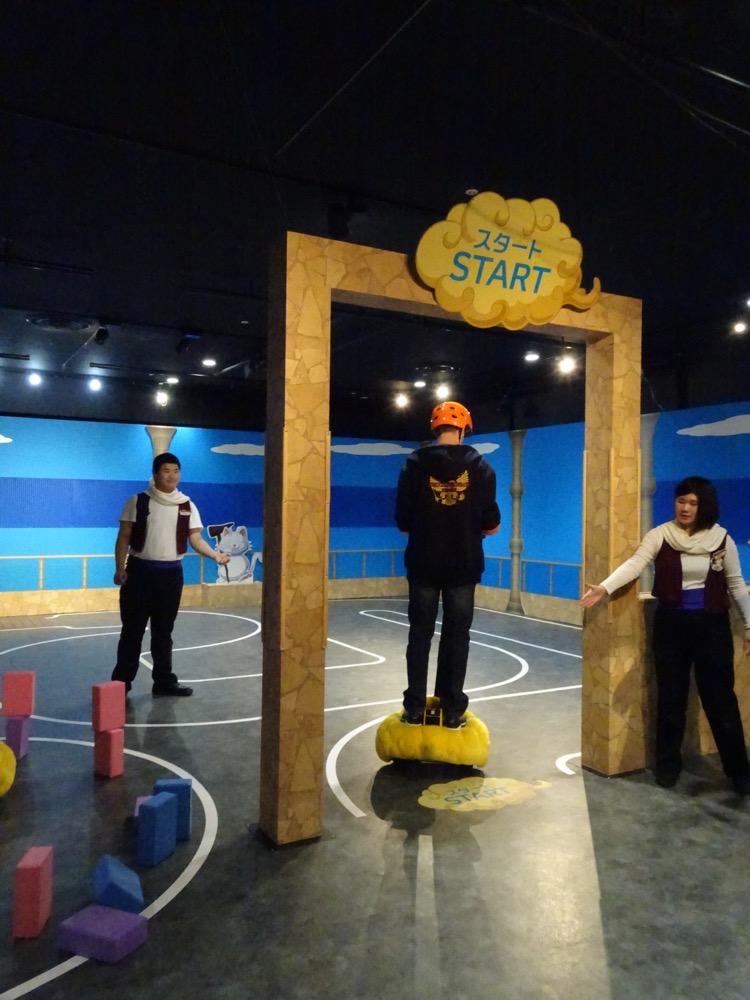
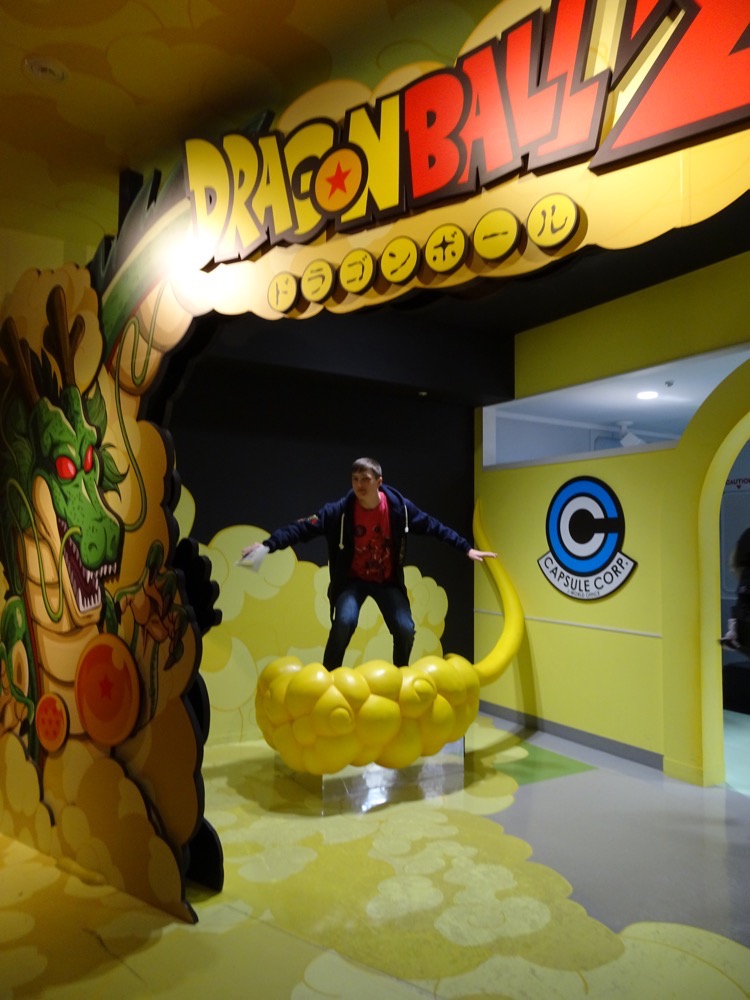


 Sake fuelled, Mr K soldiers on through his biru while we wait for some dinner.
Sake fuelled, Mr K soldiers on through his biru while we wait for some dinner. 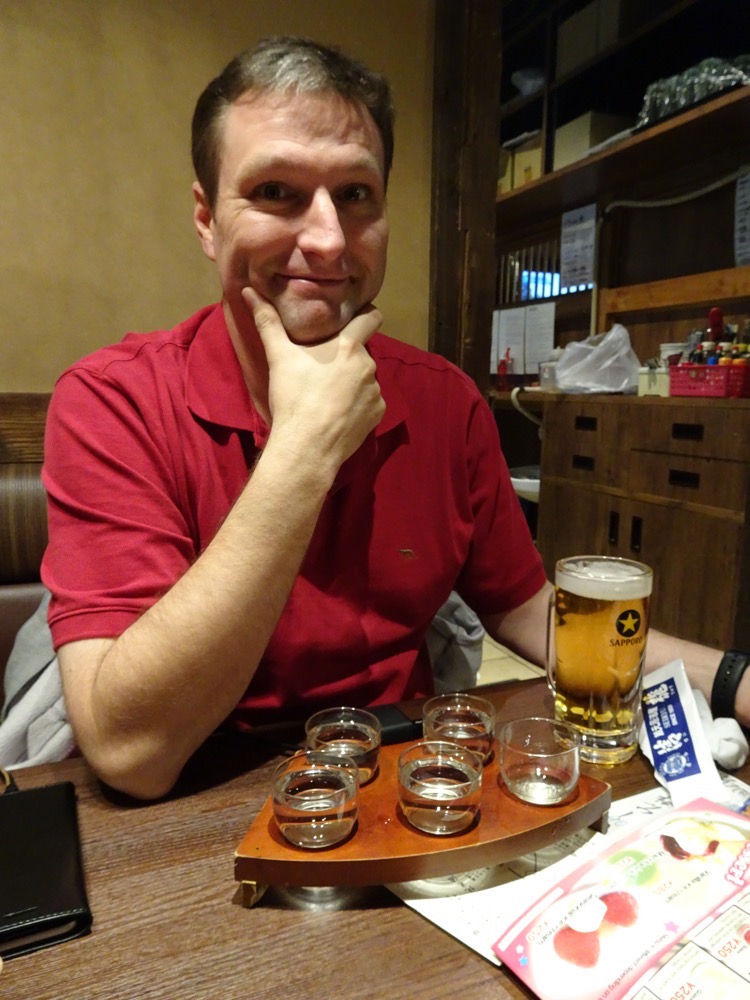 Ooh.. maybe there is fugu / blowfish on the menu? Do we risk it? Ah, not so much.
Ooh.. maybe there is fugu / blowfish on the menu? Do we risk it? Ah, not so much.  Drinking on an empty stomach is never advisable but dinner was well worth waiting for… fresh sashimi – the tuna is so much better here, I swear all the tuna we have in Australia at sushi restaurants is frozen, or frozen poorly or something. In comparison, I can honestly say I have never had good tuna back home, excepting maybe Sono at Hamilton. The texture is entirely different.
Drinking on an empty stomach is never advisable but dinner was well worth waiting for… fresh sashimi – the tuna is so much better here, I swear all the tuna we have in Australia at sushi restaurants is frozen, or frozen poorly or something. In comparison, I can honestly say I have never had good tuna back home, excepting maybe Sono at Hamilton. The texture is entirely different.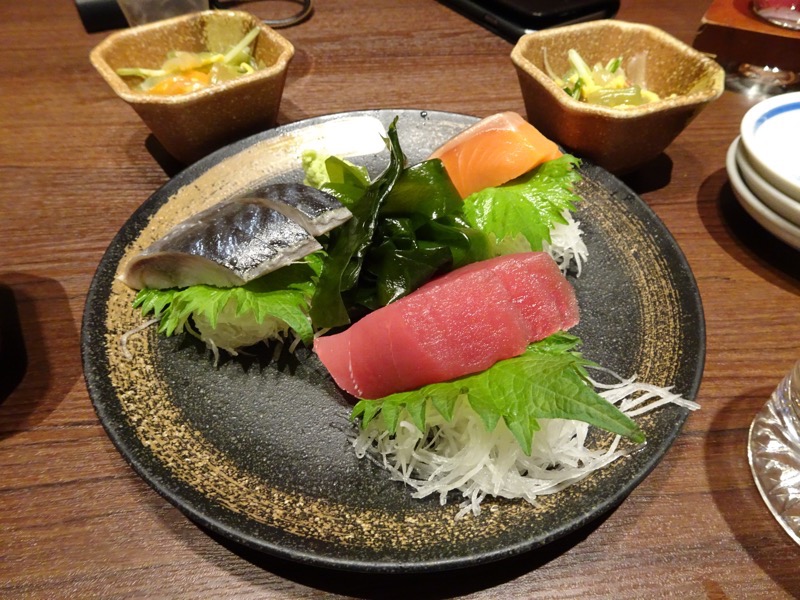 Grilled chicken and pork pot stickers.
Grilled chicken and pork pot stickers. Gyoza – of course, no meal seems to be complete without some.
Gyoza – of course, no meal seems to be complete without some.
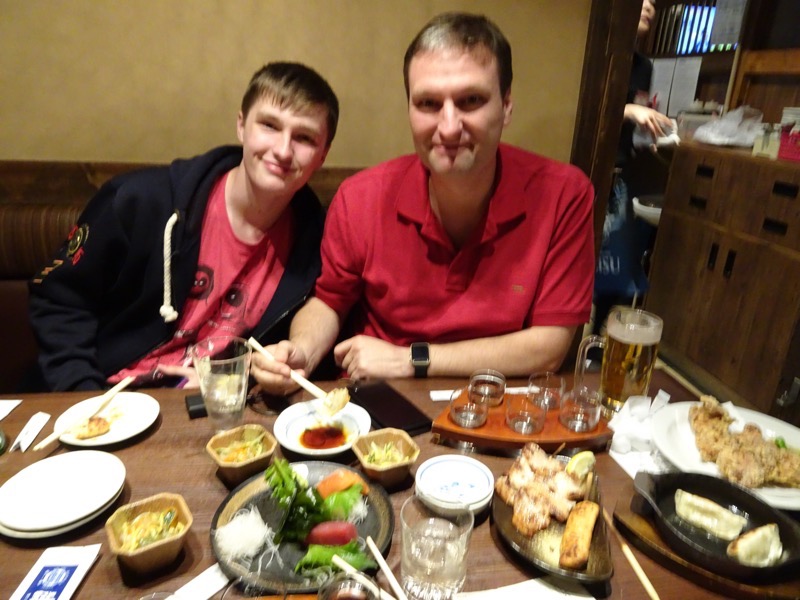 Some weird bean sprout omelette yumminess the name of which I can’t remember.
Some weird bean sprout omelette yumminess the name of which I can’t remember.
 Sake! All the sake!
Sake! All the sake!
 Then it was back to the trains – have I mentioned how awesome Tokyo trains are? Cheap, clean, efficient… kinda easy to navigate once you get the hang of them, super easy to navigate if you travel with your own transport industry professional! 😉 They’re great, and people are polite and mind their space, I love them – to go to Tokyo Tower.
Then it was back to the trains – have I mentioned how awesome Tokyo trains are? Cheap, clean, efficient… kinda easy to navigate once you get the hang of them, super easy to navigate if you travel with your own transport industry professional! 😉 They’re great, and people are polite and mind their space, I love them – to go to Tokyo Tower. Several stops and what seemed only a few minutes later, and up we pop in a new part of town, and the Tokyo Tower in front of us. Tokyo Tower is a communications with public observation decks in the Shiba-koen district of Minato. At 332.9 metres (1,092 ft), it is the second-tallest structure in Japan. Apparently it is inspired by the Eiffel Tower, and it is not difficult to see how. Allegedly, its distinctive orange and white colours come from a necessity to comply international air safety regulations…which then begs the question why isn’t the Eiffel Tower orange and white? Hmmm. #showerthoughts
Several stops and what seemed only a few minutes later, and up we pop in a new part of town, and the Tokyo Tower in front of us. Tokyo Tower is a communications with public observation decks in the Shiba-koen district of Minato. At 332.9 metres (1,092 ft), it is the second-tallest structure in Japan. Apparently it is inspired by the Eiffel Tower, and it is not difficult to see how. Allegedly, its distinctive orange and white colours come from a necessity to comply international air safety regulations…which then begs the question why isn’t the Eiffel Tower orange and white? Hmmm. #showerthoughts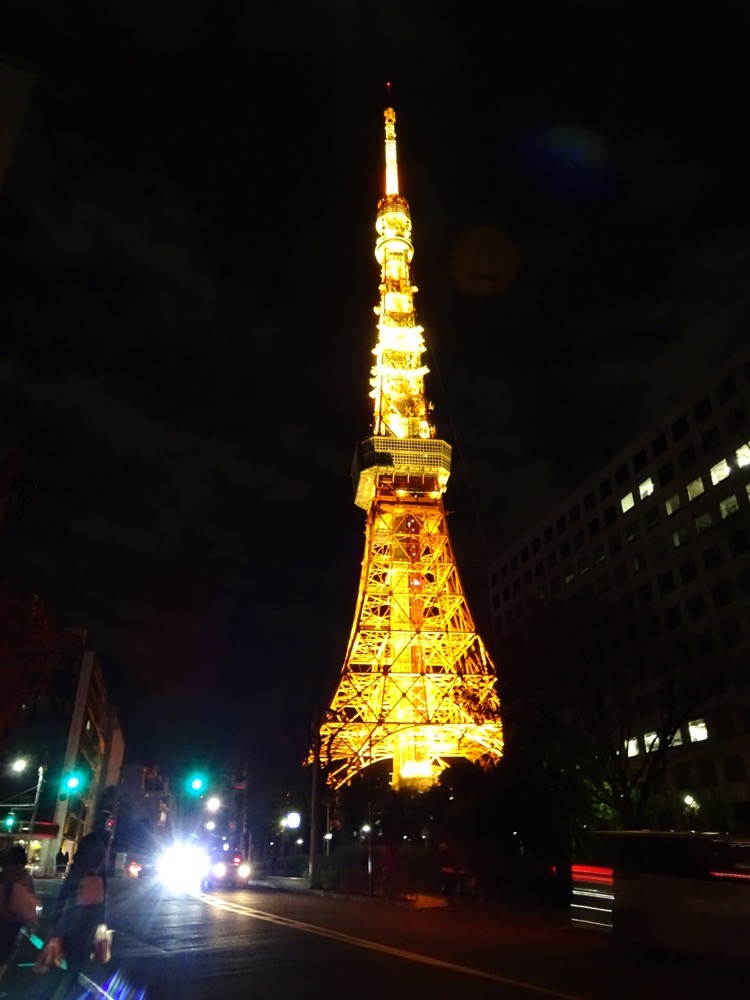 I came here on our last trip to Tokyo and it was pretty cool to get a chance to go up the tower at night as well as having been up during the day. At the moment it is all Christmassy – lights, themed photos, projected snowflakes everywhere, and live performers on the observation deck.
I came here on our last trip to Tokyo and it was pretty cool to get a chance to go up the tower at night as well as having been up during the day. At the moment it is all Christmassy – lights, themed photos, projected snowflakes everywhere, and live performers on the observation deck. 
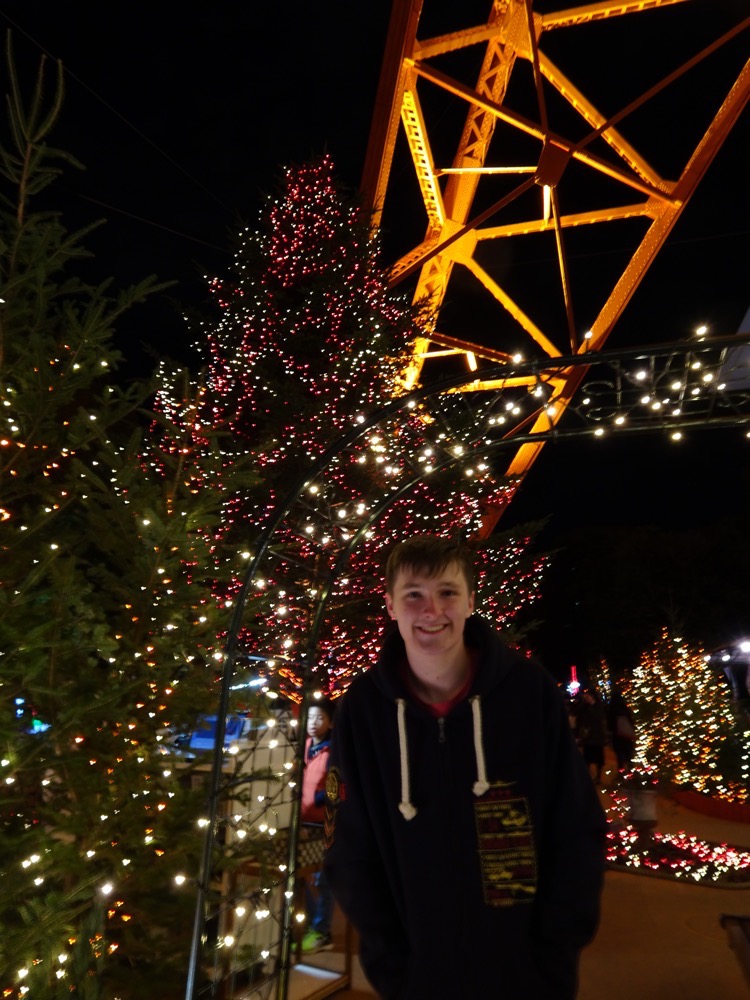 Oddly, but completely in keeping with our visit to J-World on Anime Day, we stumbled onto a One Piece 20th Anniversary exhibit and store at the Tower. There is Nami again in her signature green bikini, and loads of cool merchandise – cooler stuff than they had at the offical store in the city.
Oddly, but completely in keeping with our visit to J-World on Anime Day, we stumbled onto a One Piece 20th Anniversary exhibit and store at the Tower. There is Nami again in her signature green bikini, and loads of cool merchandise – cooler stuff than they had at the offical store in the city.
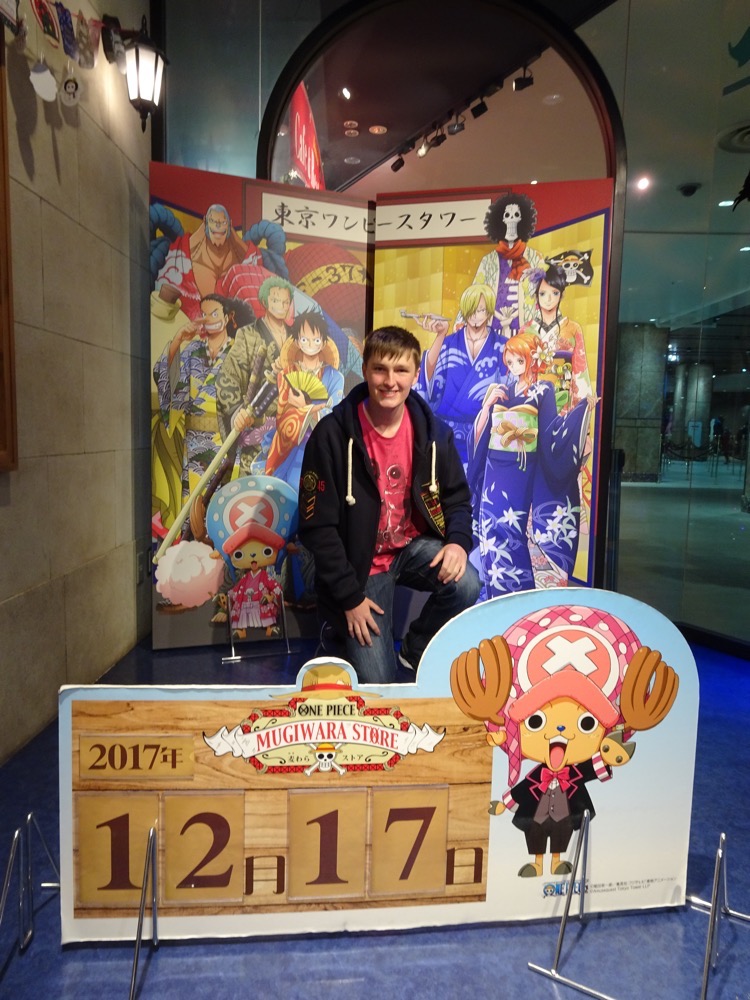 More One Piece – the little guy above with the ‘X’ on his hat is called Chopper, and he is supposed to be a reindeer that area a Hito Hito No Mi devil fruit which makes him anthropomorphic (or as the Teenager would say – makes him into a human hybrid or allows him to have human characteristics at will).
More One Piece – the little guy above with the ‘X’ on his hat is called Chopper, and he is supposed to be a reindeer that area a Hito Hito No Mi devil fruit which makes him anthropomorphic (or as the Teenager would say – makes him into a human hybrid or allows him to have human characteristics at will).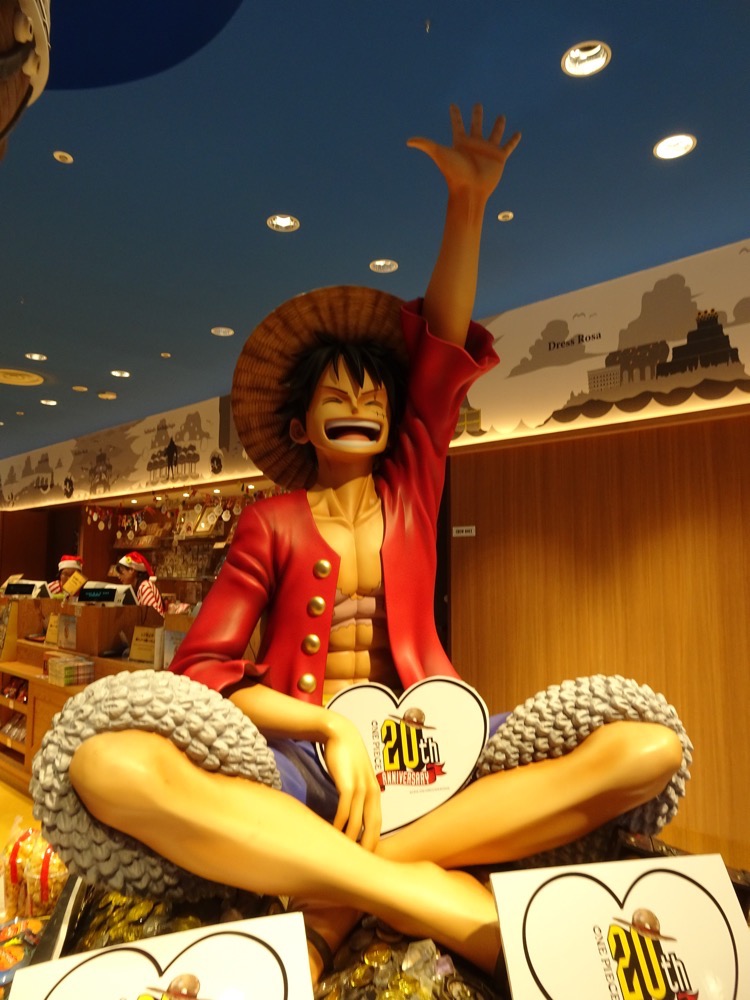
 Anyway, back to the Tower… it was covered in projected snowflakes and sparkly Christmassy stuff. It was lovely.
Anyway, back to the Tower… it was covered in projected snowflakes and sparkly Christmassy stuff. It was lovely.  The views were great and my little handheld camera either totally didn’t cope or I was completely inept, because my photos from up the Tower are not great.
The views were great and my little handheld camera either totally didn’t cope or I was completely inept, because my photos from up the Tower are not great.

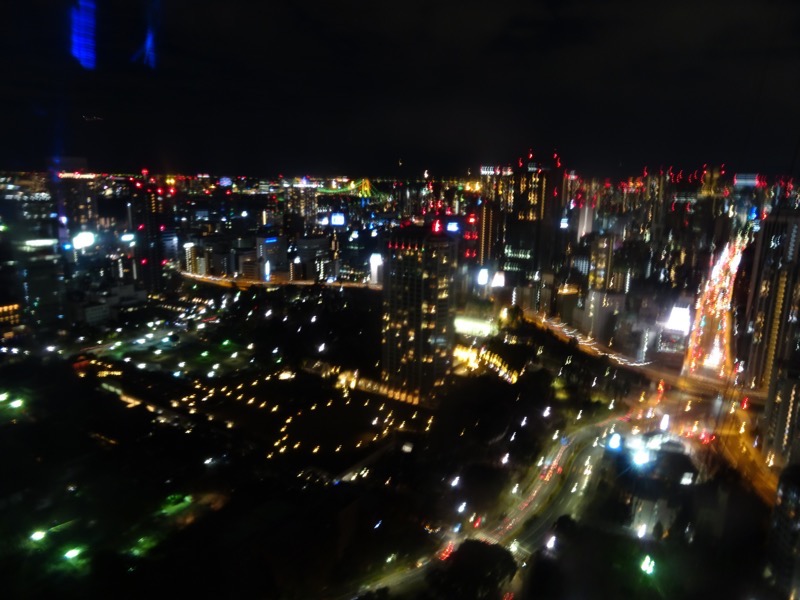 We stopped for a bit and had a blindingly sweet coke spider (yes, it’s freezing cold outside but there is still ice cream and frozen treats everywhere) and then after that sugar rush my photos got way better. 😉
We stopped for a bit and had a blindingly sweet coke spider (yes, it’s freezing cold outside but there is still ice cream and frozen treats everywhere) and then after that sugar rush my photos got way better. 😉 
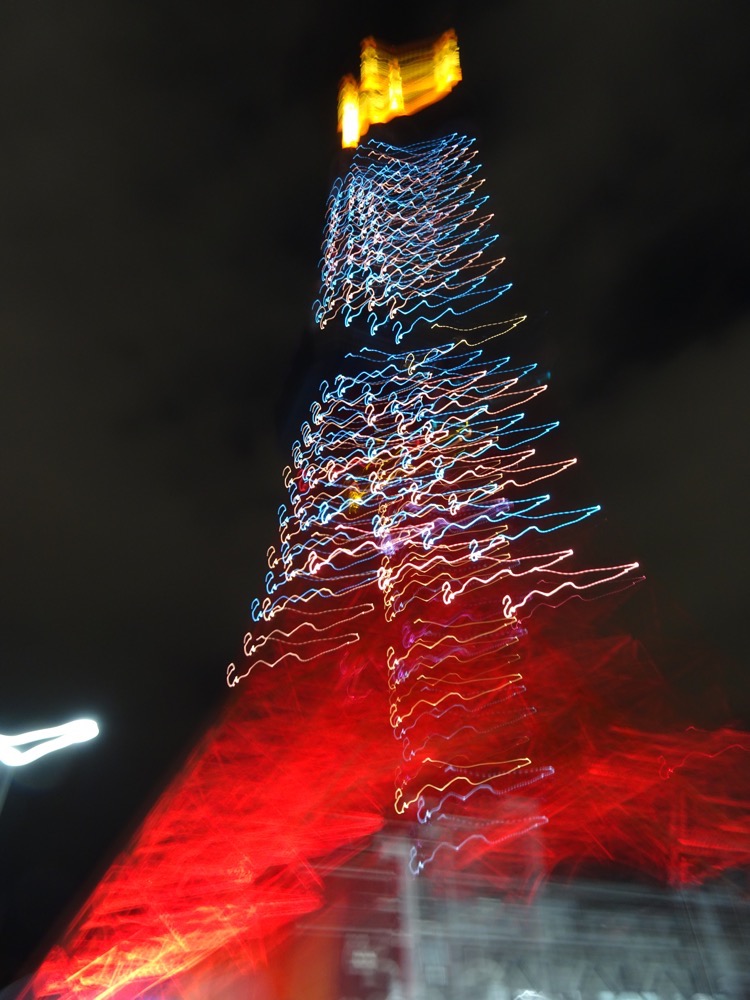 Thus endeth out second day in Tokyo! 🙂
Thus endeth out second day in Tokyo! 🙂